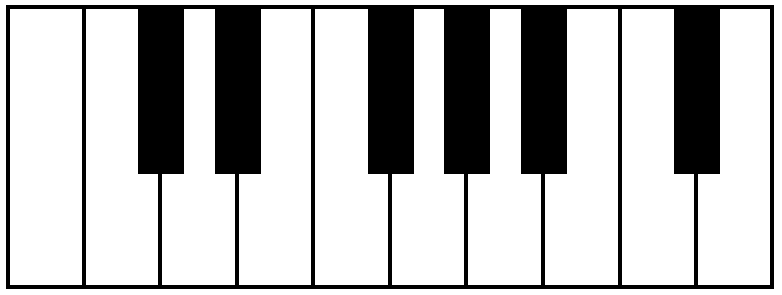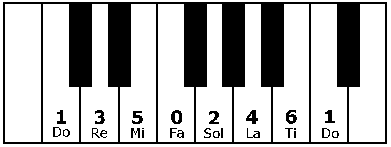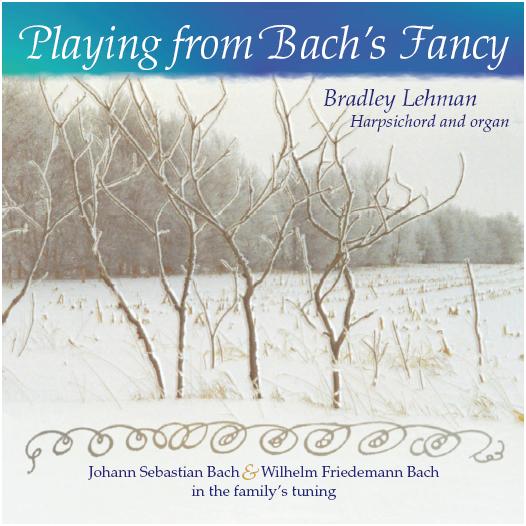 LaripS.com, © Bradley Lehman, 2005-22, all rights reserved. All musical/historical analysis here on the LaripS.com web site is the personal opinion of the author, as a researcher of historical temperaments and a performer of Bach's music. Bach's Art of Temperament
© Bradley Lehman, April 2006 (with several improvements added June 2006)
IntroductionTuning historian J Murray Barbour wrote in a 1947 article: "Explanations of the tuning of the musical scale are usually so full of figures that the non-mathematician shies away from them in terror. This is unfortunate, for the subject is not only of interest to the musicologist and theorist, but of immediate and practical concern to the performer." (Barbour, "Bach and the Art of Temperament", Musical Quarterly 33/1, January 1947)
Tuning also has direct impact on listeners: affecting the expressive powers of the music, and the resonance and melodic character of the instruments. Let us visit some of the basic practical matters, without calculations.
We will work our way toward a method of keyboard tuning I believe was notated by Johann Sebastian Bach. My 2004 hypothesis in that regard is based on both his music and a drawing by him, in his textbook about musicianship in all keys.
PerspectiveThere are hundreds of reasonable ways to tune keyboards for the classical repertoire. Their appropriateness depends on several questions. Do they clarify the music, aiding its beauty and strengths? Is the tuning historically plausible for the composer's context or known practices? Does the tuning allow the music, the instruments, and the performers to sound competent - or better yet, inspired? Is the tuning for all-purpose use (a whole concert or a whole season), or for some more restricted set of compositions?
Obviously, all this quickly becomes a minefield of historical, practical, and aesthetic issues. What is a proper balance of musical, antiquarian, and practical priorities as we choose a method to set up the keyboard for any specific day, or any specific repertoire?
Here is the familiar appearance of a keyboard. See Figure 1.
Figure 1:
As we zigzag through the white and black keys, the notes might look equally spaced, or nearly so. However, the pitches produced need not be evenly spaced (as most of us are accustomed to hearing from modern equal temperament on pianos and organs). A keyboard is merely a set of levers to activate whatever pitches have been programmed into their opposite ends. The layout can offer additional musical choices, with much music sounding aesthetically "better", if not all the pitches are required to be equally spaced.
"Tempering" refers to a bit of impurity that is introduced deliberately into an otherwise perfectly harmonious interval, such as a 5th or a 4th on the keyboard. The pitches are put slightly off their expected positions, giving a vibrato-like wobble when both notes are played together. There is impurity, asymmetry, and subtle variety: if used carefully, all of these features can strengthen the musical effects and enliven the sound.
It is a principle similar to fashioning objects with metal alloys, deliberately introducing impurities: the synthesized blend can be designed with a desired hardness, elasticity, strength, weight, cost, spring, lustre, colour, to be waterproof, etc. - qualities not available simultaneously in a single pure metal. A careful alloy helps the resulting tool (in our case, a musical scale instead of a bolt or a spanner) to be more durable and reliable than it would be with absolutely natural and pure elements.
Why are clever tuning schemes necessary at all, on keyboards? The short answer is: nature has not provided any definitively obvious way in which all the available material (within a musical octave) fits most neatly into twelve small packages, to serve all possible musical needs. If we try to tune everything directly as well as possible, we quickly run into dead-ends where other note combinations do not sound as good, since they were not given such direct attention. We must add some careful refinements and deliberate impurities, along the way, for the final result to work out well.
As Johann Sebastian Bach instructed his son Carl Philipp Emanuel on the topic of combining musical influences: "Though one style may on the whole be better than another, there is nevertheless something of particular value in each, and no style is so perfect that it will not suffer any additions. Through these additions and refinements we have progressed up to this point, and we shall progress even farther; but this will never come about if we pursue and, so to say, worship only one style; on the contrary, we must utilize all that is good, no matter where we may find it." I believe this applies to the structure of musical intonation, as well: blended styles of scales.
All the notes, and groups of notes, must work together reasonably. The requirements of harmony and melody are already in some conflict with one another, as to balancing resonant stasis vs forward motion through the time of a composition. Each individual pitch has relationships with (at least) the semitone, tone, minor 3rd, major 3rd, and 5th above it...and below it. All is delicate balance: the resulting set of pitches must sound musically satisfying (and, one hopes, also historically plausible) for whatever music is to be played on the instrument.
Bach's DrawingWhen a musician has a nicely workable layout, it is convenient if it can be reproduced again on other occasions. I have hypothesized that Johann Sebastian Bach himself had at least one practical solution that was regularly usable...and that he wrote it down on the title page of his music most concerned with issues of tuning: his main personal copy of the Well-Tempered Clavier, containing exemplary music in all 24 keys. As a textbook for teaching Bach's Leipzig students and his own children, the WTC probes the musical effects and playing techniques of all the major and minor scales.
Figure 2:
The oddly asymmetric line drawing at the top of that page looks suspiciously like a carefully-proportioned diagram. Its irregularity suggests that it is meaningful, and not merely an unbalanced decoration. See Figure 2. Some others before me, and since, have suggested that this Bach drawing indicates something else (decorative, mathematical, musical, or otherwise). Perhaps it conveys no measurable information that is reliable enough for some people's own epistemology; or perhaps it was only fanciful for Bach's own amusement.
Or perhaps, as I believe, the drawing is a direct depiction of Bach's keyboard-tuning method. It supplies the minimum amount of sufficient information to set twelve appropriately adjusted notes to "well-tempered" taste...if one knows how to read it properly! That secret may have died with him - if there ever was one. But, we can make reasonable guesses at an appropriate harmonic/melodic balance: using as corroborative evidence the historical context plus the sound and expressive range of Bach's music.
Any meaningful interpretation of the drawing must fit into musical taste and the behavior of the appropriate instruments, in practice. We must deliver performances, improvisations, and compositions of satisfying music. With various arguments presented to interpret Bach's clues, or to decide what constitutes evidence at all, we must never lose sight of the main goal: which is to catalyze the production of beautiful music.
Tuning ProcessLet us now work out a specific tuning process from Bach's drawing. My temperament layout derived from this is a very simple sequence, working hands-on at a harpsichord. This method takes only a few minutes, by ear. The drawing suggests both the strategy of working on the notes, and the relative amounts of tempering necessary along the way. The crucial listening process is to sense how much of a deliberate spice or wobble is being added to an otherwise pure 5th or 4th, by knocking one of the interval's two notes slightly out of tune.
A general principle: when we tune seven notes in sequence by 5ths (or by going the opposite direction by a 4th), those seven notes give us a complete major scale. Fa-Do-Sol-Re-La-Mi-Ti gives us all the notes connected by 5ths, and in conventional scale order this is Do-Re-Mi-Fa-Sol-La-Ti[-Do]. This basic structure of diatonic scales is explained fully in Easley Blackwood's book; see the "Further resources" below.
The character of that major scale, in intonation, is determined by how nearly we make those 5ths pure as we go along. They might be tuned exactly pure, or slightly tempered either narrow or (less commonly) wide. The notes La, Mi, and Ti are especially open to tasteful adjustment, occurring near the end of the sequence: by the time they are generated, we can hear how they fit into the scale both melodically and harmonically, and make any slight alterations that seem prudent.
Most harpsichord temperaments are generated by some simple set of rules for this process: describing the tasteful character of those pure or tempered 5ths. The easiest rule is to make all those 5ths the same size as one another (see the Reference discussion of "meantone", below). In the case of Bach's tuning style, I believe he has drawn a simple picture of those rules to adjust the 5ths/4ths, using a careful variety of three sizes.
With regard to Bach's drawing, I take another of my conceptual models from the physical process of tuning a harpsichord: from the tuning-pin's position where an interval is sounding as pure, how many units of slightest nudge on the tuning lever does it take to rotate the pin, to deliver the appropriate impurity? One micro-nudge, two, or none (leaving the interval pure)? This practical business of nudging the rotation is all there is to it, once one knows the appropriate pattern of which notes to nudge and by how much. Each nudge causes an increased "twang" in the interval's quality, on very close listening.
Figure 3:
We establish all of the keyboard's natural notes first (the white notes on pianos or most organs - obtaining the C major scale of C-D-E-F-G-A-B-C; Do-Re-Mi-Fa-Sol-La-Ti-Do), and then proceed to the sharps/flats to finish. The C major scale uses the common practice of medium tempering on the 5ths F-C-G-D-A-E, with a consistent size: two nudges from pure. Each 5th in turn (F-C, C-G, etc.) is made slightly too small, and this helps the quality of major 3rds (F-A, C-E, etc.) when they result from the several tempered 5ths in succession (F-C-G-D-A).
The exceptional step is the last one, E-B. The loop between them has no nudges in it, and I believe this indicates a pure 5th. We have tuned Fa-Do-Sol-Re-La-Mi-Ti (F-C-G-D-A-E-B); and that last step of the pure E-B (generating Ti) makes that note B a slight bit higher in pitch, which helps it to serve well as a "leading tone" upward to Do. The C major notes were derived with consistent tempering on all the intervals F-C-G-D-A-E. This is true not only for this Bach layout, but for all the common "meantone" schemes back into the 17th century and earlier: regularity and consistency as a base, at least within the natural notes.
Instead of continuing into the sharps/flats with that same "two nudges" consistency off both ends, our aim here is to make them tastefully irregular in a way that improves their utility. This is "modified meantone" (see the Reference section, below) or "ordinary" practice, from the 17th century forward: to preserve as much illusion of regularity as possible, while making additional scales sound beautiful beyond those with two sharps or flats in the key signature. Such temperaments allow keyboards to be played in all or most keys, without extreme dissonance, and providing interesting variety among the scales and chords. The farther these systems evolved in both practice and theory, into the 18th century with dozens of examples, adjustments began to affect the naturals as well. Some of these increasingly irregular systems are occasionally described today as "well-temperament," but that is a modern (and ungrammatical!) term, turning Bach's adjective "Wohltemperirte" into a noun.
With the notes of C major already installed, it remains for us to find a source for the five accidentals. These are the keyboard's raised notes, usually black by contrasting color - and these notes can be found most conveniently in the B major scale, B-C#-D#-E-F#-G#-A#-B. The notes when arranged by 5ths (Fa-Do-Sol-etc.) are the sequence E-B-F#-C#-G#-D#-A#.
The same way that we took the first half of the diagram for the seven notes of C major, we take the other half to generate B major. These two scales have the notes E and B in common. E is "Mi" of C major and "Fa" of B major; B is "Ti" of C major and "Do" of B major.
The Bach diagram, continuing where we stopped before, gives us three plain loops (pure 5ths) for E-B-F#-C#, and then three single-nudge loops for the remaining C#-G#-D#-A#. Our start with several pure 5ths gives the B major a "Pythagorean" character (see the Reference section, below), but then the notes G# (La), D# (Mi), and A# (Ti) each get a tasteful downward adjustment that removes some of their bright edginess. E-B-F#-C#-G#-D#-A#; Fa-Do-Sol-Re-La-Mi-Ti...where the concluding La-Mi-Ti have been slightly altered.
We now have generated all twelve notes that we need to play music on this "well-tempered" keyboard. Like the whole book of Das Wohltemperirte Clavier, the music starts with the rudiments in the C major scale and it ends in B, giving us a play through everything else in between. Both the C major scale and the B major scale have been generated by a series of 5ths/4ths: Fa-Do-Sol-Re-La-Mi-Ti, adjusted carefully to taste so everything works out. With the overlapping of E and B common to both, these two seven-note scales together give us the complete chromatic scale of all twelve.
In review, our 5ths are tempered as follows: F-C-G-D-A-E with the medium amount in common practice; then E-B-F#-C# pure; then C#-G#-D#-A# tempered with only a light amount, as a compromising average. The whole line is therefore: F-C-G-D-A-E-B-F#-C#-G#-D#-A#, typically taking either the C or the A from a tuning fork to start setting up the naturals. Bach's diagram has given us a map of the appropriately tasteful adjustments. The leftover interval of A# back to F - technically a "diminished 6th" - is not tuned directly; it is very nearly pure anyway, as a checkpoint that we have not ruined ourselves with cumulative errors. The complete mapping is shown in Figure 3 (or we could read Figure 2 from right to left). Figure 3, repeated:
In practice, sitting at the keyboard with our tuning lever and referring to Bach's diagram, this is much simpler to do than it might appear in all the theoretical explanation above. Just do this: wherever those "knots" appear inside the loops, make that note slightly lower than it would sound at the pure position, by nudging the tuning lever counterclockwise to "impurify" that 5th or 4th deliberately. The picture shows the whole sequence. It takes less than four minutes, with experience. Some doubly-nudged 5ths, then some pure 5ths, then some singly-nudged 5ths, and we're done.
All 24 Major/Minor ScalesAs a result, all 24 major and minor scales become usable and distinctive, with a smooth variety passing through all modulations. Each key signature uses some different blend of the notes borrowed from B major and C major, the two halves of the diagram, sharing the central loop. If our music needs flats instead of sharps, we simply rename the entire B major scale on the keyboard: Cb, Db, Eb, Fb, Gb, Ab, Bb, Cb. All twelve notes of the chromatic scale do double duty, triple duty, and more as they are used within many more scales than merely C and B majors.
Our scale alloy makes the entire layout thoroughly flexible, and just barely irregular enough that it holds and renews a listener's attentions. The adjustments are all so subtle that nothing sounds unduly odd: yet there is enough spice that we avoid the immobilizing blandness of equal temperament. Risking a metaphysical comment: this temperament makes keyboard instruments seem magically alive and alert, in the handling of tonal music.
How does this temperament affect musical practice? Intonation can influence a sensitive keyboard player's phrasing, dynamics, timing, articulation, and analysis of a composition. Because all the scales are differently patterned from one another, the ear can pick up clues each time the music shifts from one scale to another. The irregularities, sensed more as hardenings or softenings than heard consciously, offer a surprise against expectations. The ear is drawn to any notes that are coming into the composition from outside the current major or minor scale of a passage, bringing attention to harmonic modulations as they happen.
This resembles CPE Bach's advice, in his essay about playing keyboard instruments, that the player should give such foreign tones a bit of extra weight or emphasis, showing off the surprise. The pattern of dynamic emphasis, due to subtleties of this temperament, matches musical examples given by both CPE Bach's essay and the flute tutorial by his colleague at Frederick's court, Johann Joachim Quantz, instructing basso continuo players in tasteful dynamics. Notes and chords are weighted by the relative amounts of dissonance they are bringing into the musical texture, the surprise against expectations.
What musical effects emerge from this temperament, in tonal music by the Bachs and others? C major and F major make the gentlest music, and E major the brightest. The overall sound is moderate and euphonious, gently melodic and harmonic, while drawing no attention to itself. It does not make an overwhelming presence, but rather it serves to catalyze beautiful and natural expression. Different characters are projected with little or no expenditure of effort by the performer.
At increasing distance from the instrument, anything beyond a meter or two, it simply sounds almost like equal temperament: always smooth. It would have sounded especially so to people who grew up in a meantone-based musical environment. It keeps meantone's relaxed, resonant effect of purity, while eliminating all the remarkably dissonant dead-ends of the exotic keys. Music seems in tune, and magically unproblematic, all the time.
ExplorationFor those who wish to explore these ideas further: the full scholarly version of this is available in Early Music (Oxford University Press) February-May 2005, and online at <www.larips.com> with the more recent news items.
This temperament's usage today
Five new CD releases during the first months of 2006 use this special keyboard tuning system, which may have been Johann Sebastian Bach's own.
Since spring 2004 many other musicians have been exploring this temperament in solo and ensemble music, and in instrument construction. The first broadcast was a fortepiano recital by Robert Hill on Swiss radio, May 2004. The BBC has broadcast ensemble performances by The English Concert and The Purcell Quartet using this in the basso continuo, and parts of the new solo CDs mentioned above. In April 2006, Netherlands Radio presented a performance of Bach's "St Matthew Passion" using this, from a concert series by the Netherlands Bach Society.
Alongside this temperament's use in hundreds of harpsichords, fortepianos, continuo organs, modern pianos, and synthesizers, it is also installed in instruments that require more hardware commitment: at least eight larger organs, several fretted clavichords, guitars with microtonal fingerboards, a bandoneon, and a carillon(!).
Additional adventures of this temperament are listed at <www.larips.com>.
Reference: Other keyboard tuning strategies, historically
Keyboard tuning methods fall historically into several competing styles, as to the size(s) of 5ths used to generate the notes. All of these styles have been brought back into use in the 20th and 21st centuries, for reasons that are variously historical, aesthetic, or practical.
Further resources
This is the full-length original version of this article; a shortened feature drawn from it appears in the BBC Music Magazine, August 2006 (Vol 14, #13), pages 42-44.
|
v Introduction > Articles - Outline - Errata - Clavichord * ArtOfTemp - TheTuning v FAQ v Practice v Theory v History v Etc v Recordings |







